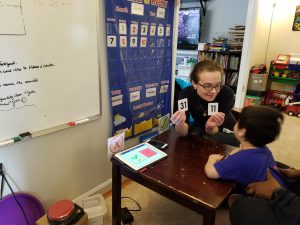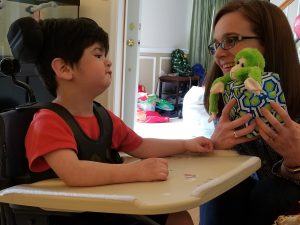 “What’s today?” I ask Joey, after we’ve counted all the numbers already posted on his wall calendar. “What comes next?” I hold up two possible choices, and every time – every time – Joey grins, stares, and then carefully moves his arm so he can clutch the card with the correct answer. It never gets old watching him proudly select the right number to put on his calendar. Although he is always correct, as his teacher I try to stay fully aware that being able to recognize what number comes next in a pattern is different than a full development of age-appropriate number sense. There are so many facets to developing mathematical thinking, and I want to be sure Joey is getting a well-rounded foundation, despite his limitations.
“What’s today?” I ask Joey, after we’ve counted all the numbers already posted on his wall calendar. “What comes next?” I hold up two possible choices, and every time – every time – Joey grins, stares, and then carefully moves his arm so he can clutch the card with the correct answer. It never gets old watching him proudly select the right number to put on his calendar. Although he is always correct, as his teacher I try to stay fully aware that being able to recognize what number comes next in a pattern is different than a full development of age-appropriate number sense. There are so many facets to developing mathematical thinking, and I want to be sure Joey is getting a well-rounded foundation, despite his limitations.
I was thrilled the other day when my Journal of Early Intervention arrived in my mailbox and included an article on how storybook read-alouds can be used to improve our preschooler’s mathematical ability. This is exactly what I hope to accomplish in my lessons with Joey. Seeing the research behind the study confirmed that Joey was experiencing and practicing number sense activities throughout our sessions.
The study focused on supporting the development of three different concepts – quantity comparisons, one-to-one correspondence counting, and oral counting.
With Joey, I’m often looking for ways to count sets of objects in books. We recently read David Shannon’s Duck on a Bike (which, by the way, includes three of Joey’s favorite AAC words – duck, on, bike). As Duck rides his bike through the farm, he talks to many different farm animals. Although this is not a counting book, we can count each animal as Duck goes past. For this book I have plastic animals to represent each animal in the story, so we can line the animals up in front of Joey as Duck greets each one. This lets us be able to not just count a set of objects, but we can also watch as the line grows as we add each new animal. “Now there are four… but one more comes… and now there are… five!” At the end of Duck on a Bike, each animal finds a bike to ride. This gives us another opportunity to work on comparing amounts and matching like-sets. For this, I have a laminated picture of the animal that velcroes onto a laminated bike. After reading the book we play a game where we spin a wheel to determine how many bikes we get to give to the animals. If Joey spins a 2, he gets to pick up two bikes and give them to two different animals. This integrates numeral recognition, selecting a set amount, and matching sets with one to one correspondence.
 We are now reading Dear Zoo , which also gives us an opportunity to count animals. In this book a child writes to the zoo for a pet, and each time the zoo sends an animal that just isn’t right (until the very end.) Here, we can make our own line of animals that the zoo sends, to work on counting with one to one correspondence, and adding on by one to a set of objects. Although the child in the book sends back each animal after he receives it, I like to wait until we’ve collected all of the zoo’s animals, and then send them back one by one, so we can watch as the line of animals gets smaller and smaller until only the puppy is left. This lets us work on those early subtraction skills.
We are now reading Dear Zoo , which also gives us an opportunity to count animals. In this book a child writes to the zoo for a pet, and each time the zoo sends an animal that just isn’t right (until the very end.) Here, we can make our own line of animals that the zoo sends, to work on counting with one to one correspondence, and adding on by one to a set of objects. Although the child in the book sends back each animal after he receives it, I like to wait until we’ve collected all of the zoo’s animals, and then send them back one by one, so we can watch as the line of animals gets smaller and smaller until only the puppy is left. This lets us work on those early subtraction skills.
Although Joey may not be able to explain his mathematical thinking to us (and really, how many four year olds can?), he’s exploring early numeracy skills through acting out story books, reading the books, and playing with items related to the books. I am hopeful all of this will improve his math skills and give him a solid foundation as he continues to learn and grow.
Green, K, Gallagher, P, and Hart, L. (2018). Integrating mathematics and children’s literature for young children with disabilities. Journal of Early Intervention, 40, 3-10.


